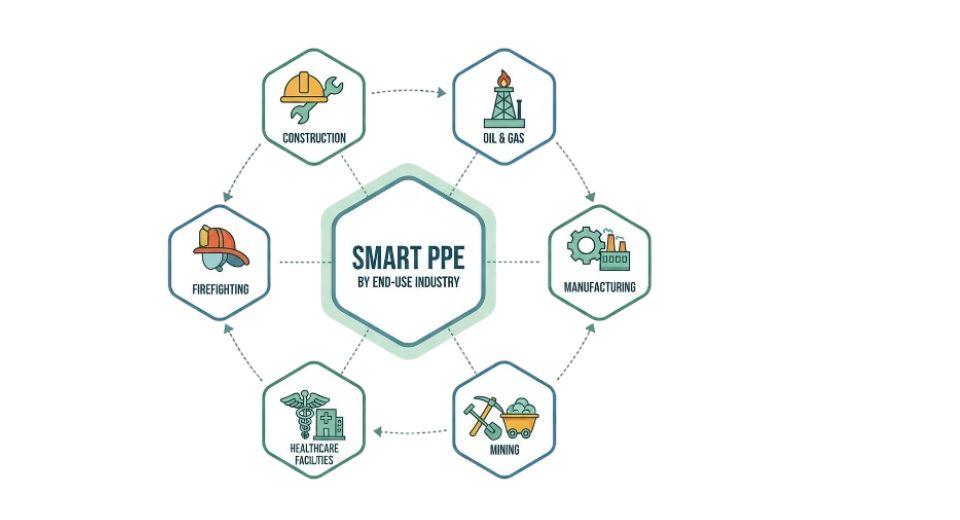
Nov 07, 2025

In factories, construction sites, and the entire industrial landscape, safety measures have evolved from just wearing helmets or gloves to the adoption of intelligent clothing that not only monitors but also surveys the environment, worker health, and even possible environmental hazards. According to the market analysis done by Metastat Insight, the global smart PPE market is a clear indication of the replacement of traditional protective equipment with the one that is equipped with sensors and connectivity as well as the increasing prominence of such equipment in the day-to-day operations of the industry.
Market Landscape
Even more so, heavy-duty operations, construction sites, and the most demanding industries such as oil & gas and mining are becoming increasingly complex; they have to deal with unpredictable hazards, very strict safety standards, and the constant need to supervise workers' well-being in real time. The conventional personal protective equipment has its place and is still necessary, however, it lacks the necessary response sometimes.
It cannot inform workers when the gas level is high, cannot track the level of fatigue of an entire crew in real-time, and cannot share information among the workers. The smart PPE market is the one that makes the communication between traditional protective equipment and digital safety ecosystems possible. In other words, it is the "enabler" for wearables, sensor-equipped garments, and connected accessories to switch from the area of passive protection to that of active risk management.
How it Works / Its Value
Smart PPE consists of standard protective clothing (helmets, vests, shoes, gloves) along with the built-in electronics, wireless connectivity, environmental sensors, and analytics platforms that come with it. The “smart helmet,” for example, may monitor the temperature, gas levels, and impacts, and send warnings to the control room. A “smart glove” might measure the operator's hand movements, detect tremors or changes in grip strength to signal fatigue or unsafe motion patterns. In addition to detecting hazards, these systems facilitate remote monitoring, compliance tracking and historical-data analysis.
Growth Story / Technological Evolution
The smart PPE market was initiated by the early experiments with wearable sensing and monitoring; these mainly took place in research institutes or high-risk sectors. As time went by, the adoption rate of the technology in mainstream industrial applications became higher acting on the low prices of sensors and the availability of connectivity everywhere.
Some breakthroughs in this regard were the use of IoT modules in standard helmets and vests and the release of safety analytics dashboards for workers. Besides these, the investments in edge analytics, AI for predicting hazards and better batteries have all contributed to furthering the technology field. All these innovations have been making the market move towards worldwide experimented and accepted deployments across industries.
Regional or Global Trends
Smart protective gear adoption in areas like North America and Western Europe; which are the main manufacturing regions, is the highest. This is mainly because of strict regulations on occupational safety, easy access to high skilled workers and the existence of big industrial projects. Asia-Pacific is a region that is on its way to catching up very fast; the rapid development of indus-
try leading to construction activities, awareness of the need to protect workers and measures taken in the area of safety are the reasons why the smart PPE market is expected to expand rapidly there. On the contrary, there is a possibility of a gradual growth of high-tech safety gear in less developed areas such as Latin America, the Middle East, and Africa, which depend mostly on the replacement of traditional safety equipment with the modern one in the large-scale industrial operations.
Challenges and Opportunities
The foremost challenges that need to be addressed are the costs associated with the deployment (smart gear still being more expensive than conventional PPE), the difficulties regarding integrations (the different systems might not work together), the longevity of batteries and sensors' ability to withstand tough conditions, and getting the necessary approvals from regulatory bodies in different areas.
Meanwhile, the digital transformation initiatives that are more or less connected (connected worker platforms, predictive maintenance) are a great source of upside. The sustainability trends that are on the rise less waste from accidents, better resource allocation through technology add to the attractiveness. Thus, the smart PPE market that is utilized in protecting the workforce and at the same time optimizing operations is positioned at a very strong turning point.
Why It Matters Now
Safety of the workforce, automation of industries, data-oriented operations, and sustainability have all become unavoidable priorities for the modern industry. The global smart PPE market as presented by Metastat Insight corresponds perfectly with these major trends: making it possible to have safer working places, facilitating the transition to smart factories and digital job sites, and assisting companies in attaining both human resources and production goals.
In a scenario where risk environments are rapidly changing and where one incident can lead to a chain of events causing harm to reputation and finances smart protective Equipment is not only a tool but a strategic investment in resilience and competitiveness. The global smart PPE market is prepared for wider deployment, and its contribution in creating the future of workplace safety has never been more considerable.
Drop us an email at:
Call us on:
+1 214 613 5758
+91 73850 57479